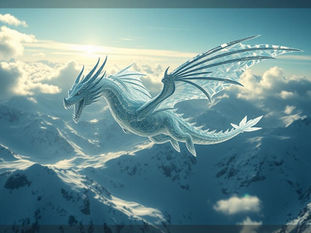
From Script to Screen: Building Animated Stories with ChatGPT and AI
Jul 29
5 min read
0
34
0

Have you ever wanted to create your own animated stories but felt intimidated by the process? What if you could use AI to handle most of the heavy lifting, from character design to scene setup? This guide shows you how to build captivating animated narratives using ChatGPT for visuals and other AI tools for animation, providing consistent characters and scenes throughout your story.
The Core Components of an Animated Story (with AI Help)
Crafting an animated story involves several key elements. Thankfully, AI can assist with each step, speeding up your creative process. Here’s what you need:
[B]Script:[/B] Your foundational story outline.
[B]Character Design:[/B] Descriptions of how your characters look.
[B]Shot List:[/B] A breakdown of unique shots for each scene.
[B]Text-to-Image Prompts:[/B] Instructions for AI to generate visuals for each shot.
[B]Image-to-Video Prompts:[/B] Instructions to animate those visuals.
[B]Dialogue/Narration Text:[/B] The spoken words for your story, used with a text-to-speech generator.
Using the Animation Script Builder GPT
To streamline this process, a specialized GPT called "Animation Script Builder" can help. This tool generates all the necessary components for each scene, allowing you to copy and paste the outputs into other AI tools.
Accessing the GPT
1. Go to chatgpt.com.
2. On the left, click "Explore GPTs."
3. Search for "Animation Script Builder."
4. Select the GPT by Emmanuel Crown and click "Start Chat."
Generating Your Story Elements
In the chat, describe your project. For example, "Write a 3D cartoon animation script about a boy getting ready for school." The GPT will ask clarifying questions about characters, their appearance, and preferred animation style. Once you provide these details, it will generate character descriptions and then, scene by scene, provide the shot list, text-to-image prompts, image-to-video prompts, and dialogue.
Leveraging ChatGPT-4o for Consistent Images
Currently, the new ChatGPT image model (GPT-4o) isn't directly supported within custom GPTs, which means images generated directly from the "Animation Script Builder" GPT might not be as high quality or consistent. To get the best results, use a workaround:
[B]Copy All Generated Script:[/B] Copy the character descriptions and all scene details generated by the Animation Script Builder GPT.
[B]Start a New Chat in GPT-4o:[/B] Open a new chat in ChatGPT and ensure you are using the GPT-4o model.
[B]Paste and Prompt:[/B] Paste your entire script and character descriptions into this new chat. Then, use prompts like "create a front view of the image of Ben on a white background" for characters, and "create the image of shot one 3:2" for scenes, specifying an aspect ratio like 3:2 for wider images. ChatGPT-4o is excellent at maintaining character consistency (appearance, clothing, environment) across multiple image generations within the same chat.
For longer scripts, characters might start to lose some consistency after many scenes. A simple fix is to re-upload the character’s reference image in your prompt when generating a new scene. For example, "create the image of shot 52" and include the character image as a reference.
Bringing Images to Life: Animation Tools
Once your images are ready, it's time to animate them. Two excellent tools for stylized 3D cartoons and animated images are Clean AI and RunwayML’s Gen-4.
Animating with Clean AI
1. Open Clean AI and click the "upload image" option.
2. Copy the "image-to-video prompt" generated by your Animation Script Builder GPT for your chosen shot.
3. Paste the prompt into Clean AI. You might need to make small edits to refine the animation (e.g., adding camera movements like zooming in).
4. Choose between Clean 1.6 or Clean 2.0. For most stylized animations without fast motion, Clean 1.6 is often sufficient and uses fewer credits. Clean 2.0 excels with fast movements and adheres more closely to prompts.
5. Click "Generate" to animate your image.
Animating and Lip-Syncing with RunwayML
RunwayML is another powerful tool, especially good for animations and lip-syncing, though it has more limited free credits. The Gen-4 and Turbo models are recommended.
Method 1: Direct Animation and Lip Sync
1. In RunwayML, click "Generate Video."
2. Upload your image and paste the "text-to-video prompt" from your GPT.
3. Select your preferred model (Gen-4 or Turbo) and generate the animation.
4. After generation, click on the video, then "Actions," and select "Lip Sync."
5. Upload your audio file and click "Generate Lip Sync."
Method 2: Advanced Lip Sync with Act One
RunwayML's Act One feature provides a natural, driven performance for lip sync:
1. Go back to RunwayML and click on "Act One."
2. Upload your animated video (from Runway or Clean AI) or an image of your character.
3. Once the face is detected, record yourself acting out the dialogue or upload a pre-recorded video. RunwayML will use your performance to drive the character's lip movements and expressions.
Adding Dialogue and Sound Design
No animated story is complete without sound. Text-to-audio generators and video editors are crucial here.
Generating Dialogue
1. Copy the dialogue text generated by the Animation Script Builder GPT for each scene.
2. Paste this text into a text-to-audio generator likeEleven Labs. This tool offers high-quality voice generation and even voice-changing options (under "Voice Changer") if you want to alter your own recorded voice.
3. Generate your audio files.
Putting It All Together with a Video Editor
Use any video editor (like CapCut, a free desktop and mobile app) to assemble your animated scenes and audio.
[B]Import and Arrange:[/B] Drag and drop all your generated video clips and audio files into the editor.
[B]Sequence Scenes:[/B] Arrange your clips scene by scene, cutting and trimming as needed.
[B]Integrate Audio:[/B] Align your dialogue and narration audio with the corresponding scenes.
[B]Sound Design:[/B] Add background music, sound effects, and ambient sounds to enhance your story. CapCut offers various built-in sound options.
Ready to take your AI animation journey to the next level? Explore the Midjourney Automation Suite from TitanXT. This tool can help automate and enhance your process, making character consistency and scene generation even easier.
Optimize Your Workflow with Automation
Creating animated stories with AI involves many steps, from prompt engineering to image generation and animation. While powerful, this process can be time-consuming. Imagine a tool that automates these repetitive tasks, letting you focus on the creative storytelling aspect. The Midjourney Automation Suite from TitanXT is designed to do just that, offering solutions to streamline your workflow for consistent character generation and efficient scene creation. Don't let manual steps slow down your animation projects. Start automating today and see your stories come to life faster.
By following these steps, you can create full animated stories with consistent characters and scenes, all powered significantly by AI. It simplifies complex tasks and allows creators to bring their visions to life with more ease.






